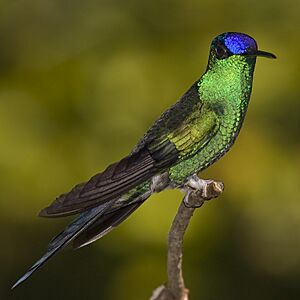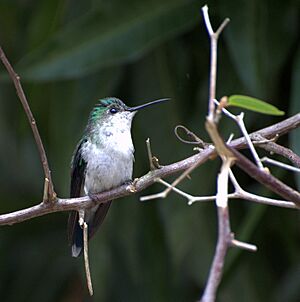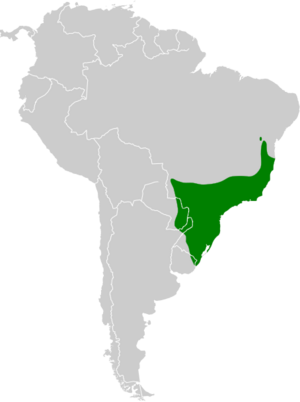Violet-capped woodnymph facts for kids
Quick facts for kids Violet-capped woodnymph |
|
|---|---|
 |
|
| Male at Campo Limpo Paulista, São Paulo State, Brazil | |
 |
|
| Female at Ilhabela, São Paulo State, Brazil | |
| Conservation status | |
| Scientific classification | |
| Genus: |
Thalurania
|
| Species: |
glaucopis
|
 |
|
The violet-capped woodnymph (scientific name: Thalurania glaucopis) is a beautiful type of hummingbird. It belongs to a group of hummingbirds often called "emeralds." You can find this tiny bird in parts of South America, including Argentina, Brazil, Paraguay, and Uruguay.
Contents
What's in a Name?
The violet-capped woodnymph was first officially described in 1788. A German scientist named Johann Friedrich Gmelin gave it its first scientific name.
The word Thalurania comes from Ancient Greek words. Thalos means "child," and ouranos means "heaven." The second part of its name, glaucopis, also comes from Ancient Greek. Glaukos means "blue-grey," and ōps means "face." This name likely refers to the bird's appearance.
What Does It Look Like?
The violet-capped woodnymph is a small bird, about 8 to 11 centimeters (3 to 4 inches) long. Males are a bit heavier than females.
Male Woodnymphs
Adult male woodnymphs have a bright, shiny violet-blue cap on their head. Their upper body is a golden-green color. They have a steel blue tail that splits into two points, like a fork. Their belly is a brilliant green.
Female Woodnymphs
Adult females look different. They are green on their upper body. Their belly is a dull white or light tan color. Their tail is only slightly forked. The inner tail feathers are metallic green, and the outer ones are steel blue with white tips.
Young Woodnymphs
Young males have a turquoise-blue cap. They also have some whitish stripes on their throat feathers. Their underparts can have grayish-brown areas. Both males and females have a straight, blackish beak.
Where Does It Live?
You can find the violet-capped woodnymph in eastern and southeastern Brazil. It also lives in northeastern Argentina, eastern Paraguay, and northern Uruguay.
These birds like to live inside and at the edges of thick forests. They also live in scrublands, which are areas with small trees and bushes. Sometimes, you can even spot them in parks and gardens in towns and cities. They live from sea level up to about 850 meters (2,800 feet) high.
How Does It Behave?
Movement
The violet-capped woodnymph moves short distances during the year. We don't know all the details about their travels yet. For example, they are only found in Paraguay during the non-breeding season.
Feeding Habits
These hummingbirds eat nectar from many different types of flowers. They find nectar from plants, shrubs, and trees at all levels of their habitat. Besides nectar, they also catch small insects. They do this by flying out from a perch to snatch insects in the air. They also pick insects off plants.
Reproduction
The breeding season for the violet-capped woodnymph is from September to February. The female builds a cozy, bowl-shaped nest. She uses soft plant fluff and fibers, decorating the outside with fern scales and lichen.
The nest is usually placed on a horizontal branch or in a fork of a tree. It's typically about 1.5 to 3 meters (5 to 10 feet) above the ground. The female lays two eggs and keeps them warm for about 15 days. The baby birds hatch and leave the nest about 20 to 25 days later.
Sounds They Make
The song of the violet-capped woodnymph is a steady, fast series of metallic "chips." It sounds like "chip..chip..chip..." when they sing. When they fly, they make short, dry "chips." Sometimes, it sounds like a dry trill or chatter.
What About Its Status?
The IUCN (International Union for Conservation of Nature) says the violet-capped woodnymph is a species of "Least Concern." This means it is not currently in danger of disappearing. It lives across a large area. We don't know exactly how many there are or if their numbers are changing. No immediate threats have been found for this bird. It is one of the most common hummingbirds in southeastern Brazil. It also lives in many protected areas there.


